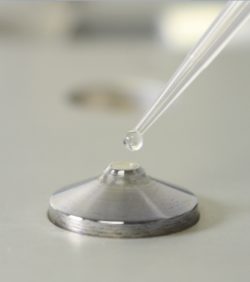Measuring the UV-light absorption of proteins is the most straightforward method of microvolume protein analysis for concentration and purity. The aromatic amino acids and residues of many proteins exhibit strong ultraviolet absorption with a peak at 280nm. The amount of light absorbed is proportional to the concentration of the sample. Using the Beer-Lambert equation, it is possible to quantify proteins as a factor of this absorptive behavior.
Direct UV absorbance measurements represent a simple and effective procedure for purified proteins, yet they are not a universal method of quantification. Instead, spectrophotometric techniques must be tailored depending upon understandings of the analyte and the presence of buffers or solvents within the sample that may interfere with direct quantification at 280nm.
This blog post will explore four of the alternative protein quantification assays used in microvolume analysis of proteins and biochemistry applications.
Bicinchoninic Acid (BCA)
The BCA, or Smith assay, is a colorimetric assay that was engineered for analysis of protein samples in solution. Prior to spectrophotometric analysis, the protein is bound with copper ions to form copper—bicinchoninic acid (Cu—BCA) chelates; a purple complex with a linear correlation between chromatic intensity and protein concentration. This complex absorbs light at 562nm and is compatible with detergents.
Bradford Assay
The Bradford assay is one of the most established colorimetric protein quantification tools for microvolume analysis. It is based on the binding of positively-charged proteins to negatively-charged Coomassie dye. This complex absorbs light at 595nm. Absorbance spectra can then be compared to standard curves to determine protein concentration.
Lowry Microvolume Analysis
The modified Lowry assay is a copper-based reagent that measures the absorbance of copper-protein complexes at wavelengths of 650nm. Like the Bradford assay, results must be estimated through comparisons with assay standard curves.
Pierce 660
The Pierce 660 assay is engineered for microvolume analysis of proteins bound to a dye-metal complex. It is compatible with solutions comprising detergents and reducing agents, exhibiting absorption at wavelengths of 660nm.
Microvolume Analysis with DeNovix
DS-11 Series Spectrophotometers are equipped to perform absorbance measurements across the full UV-Vis spectrum, enabling microvolume analysis of protein samples using direct quantification using the 280nm absorbance and the most common colorimetric assays on the market. This is enhanced by the standard curve capability, which graphs 2 – 8 standard curves for rapid comparative analysis of absorbance values. The DS-11 is uniquely suited for quantifying BSA, IgG, and custom proteins in sample volumes as small as 1 microliter (μl), with full implementation of the above protein assays.
If you would like any more information about performing microvolume analysis with DeNovix equipment, simply contact us directly.



